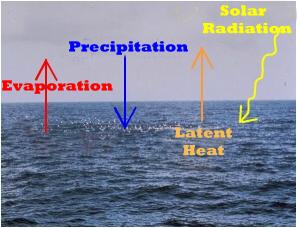Types of systemsSystems can be classified as open, closed, or isolated. Open systems allow energy and mass to pass across the system boundary. A closed system allows energy but not mass across its system boundary. An isolated system allows neither mass or energy to pass across the system boundary. Open Systems
The ocean is an example of an open system. The ocean is a component of the hydrosphere and the ocean surface represents the interface between the hydrosphere and the atmosphere that lies above. Solar radiation passes through the atmosphere and is absorbed by the ocean. The absorbed energy evaporates water from the ocean. As water vapor (mass) enters the atmosphere it carries with it the heat used to evaporate the water (called latent heat) and raises the air's humidity. If the humidity is high enough, condensation occurs, latent heat is released, and clouds are created. Continued condensation creates precipitation (mass) that falls back into the ocean. Hence, energy and heat (solar radiation, latent heat) as well as mass (water vapor and precipitation) passes across the boundary between the atmosphere and hydrosphere. All of the "spheres" of the earth system are considered open systems because energy and mass is exchanged between them. Closed Systems
Figure 2.23 The
Earth as a closed system The earth system as a whole is a closed system. The boundary of the earth system is the outer edge of the atmosphere. Virtually no mass is exchanged between the Earth system and the rest of the universe (except for an occasional meteorite). However, energy in the form of solar radiation passes from the Sun, through the atmosphere to the surface. Earth in turn emits radiation back out to space across the system boundary. Hence, energy passes across Earth's system boundary, but not mass, making it a closed system. The interface between systems is not always easy to identify, others more so. The interface between the hydrosphere and lithosphere at a shoreline is easy to recognize as a definite planar boundary between a solid and fluid. The interface between the atmosphere and hydrosphere is less easy to discern as the hydrosphere comprises both liquid water of the surface and water held in the air. |
Concept CheckEnter your answer in the text box below and click the submit button.
|
|
|


